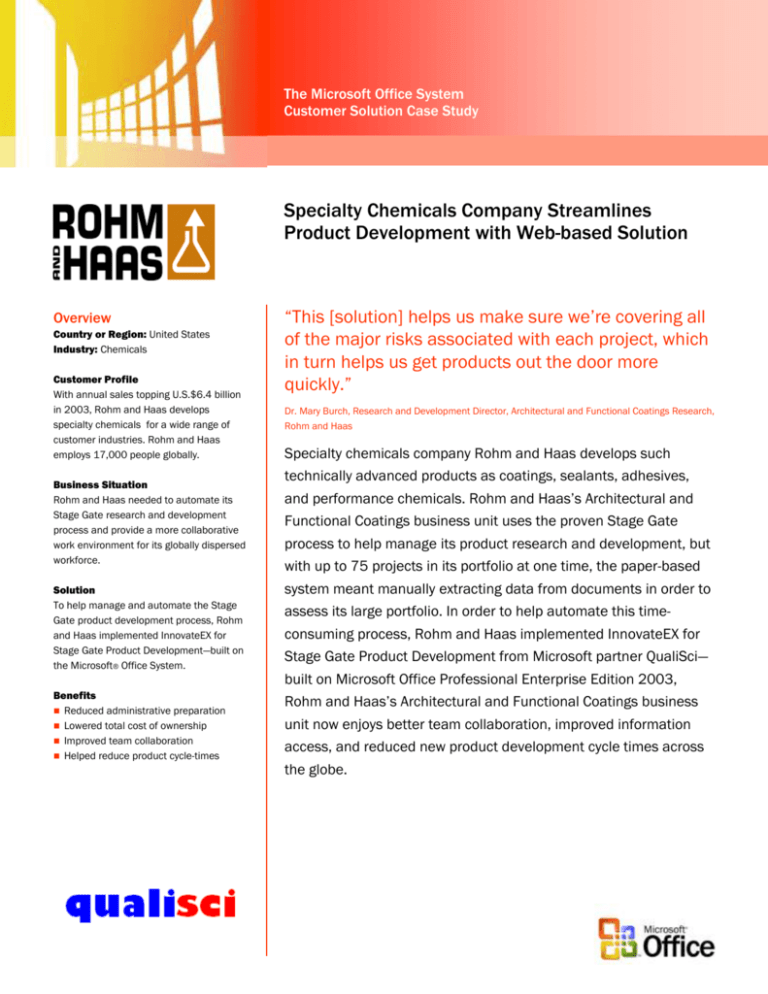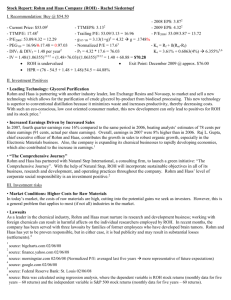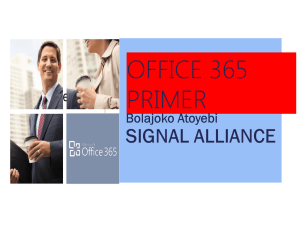
The Microsoft Office System
Customer Solution Case Study
Specialty Chemicals Company Streamlines
Product Development with Web-based Solution
Overview
Country or Region: United States
Industry: Chemicals
Customer Profile
With annual sales topping U.S.$6.4 billion
in 2003, Rohm and Haas develops
specialty chemicals for a wide range of
customer industries. Rohm and Haas
employs 17,000 people globally.
Business Situation
Rohm and Haas needed to automate its
Stage Gate research and development
process and provide a more collaborative
work environment for its globally dispersed
workforce.
Solution
To help manage and automate the Stage
Gate product development process, Rohm
and Haas implemented InnovateEX for
Stage Gate Product Development—built on
the Microsoft® Office System.
Benefits
Reduced administrative preparation
Lowered total cost of ownership
Improved team collaboration
Helped reduce product cycle-times
“This [solution] helps us make sure we’re covering all
of the major risks associated with each project, which
in turn helps us get products out the door more
quickly.”
Dr. Mary Burch, Research and Development Director, Architectural and Functional Coatings Research,
Rohm and Haas
Specialty chemicals company Rohm and Haas develops such
technically advanced products as coatings, sealants, adhesives,
and performance chemicals. Rohm and Haas’s Architectural and
Functional Coatings business unit uses the proven Stage Gate
process to help manage its product research and development, but
with up to 75 projects in its portfolio at one time, the paper-based
system meant manually extracting data from documents in order to
assess its large portfolio. In order to help automate this timeconsuming process, Rohm and Haas implemented InnovateEX for
Stage Gate Product Development from Microsoft partner QualiSci—
built on Microsoft Office Professional Enterprise Edition 2003,
Rohm and Haas’s Architectural and Functional Coatings business
unit now enjoys better team collaboration, improved information
access, and reduced new product development cycle times across
the globe.
“InnovateEX enables us
to take a whole array of
projects and transform
that into an entire
portfolio analysis—and
it’s as simple as pushing
a button.”
Dr. Mary Burch, R&D Director, Architectural
and Functional Coatings Research, Rohm and
Haas
Situation
Rohm and Haas is a specialty chemicals
company with 17,000 employees and over
100 worldwide manufacturing sites focused
on delivering technically advanced products
to customers in over 100 countries. With
2003 sales topping U.S.$6.4 billion, it
creates adhesives, sealants, coatings,
electronic materials, monomers, performance
chemicals, and salts for such markets as
building products, personal care, consumer
electronics, transportation, paper and
packaging, pharmaceuticals, construction,
and computer hardware.
The Architectural and Functional Coatings
business unit is Rohm and Haas’s largest
business unit with over 3,000 employees and
sales nearing U.S.$2 billion annually. Its
customers require the Architectural and
Functional Coatings business unit to develop
a wide spectrum of products—from industrial
applications, like paint for bridges; to
products for graphic arts applications, like ink
or digital imaging products; to consumer
applications, like decorative paints. In a
business unit the size of Architectural and
Functional Coatings, up to 140 individual
projects in research and development and
sales directed projects can make up a
portfolio, a sizeable undertaking for the
research and development (R&D) team.
Rohm and Haas’s Architectural and
Functional Coatings business unit uses the
Stage Gate process to help manage its
product development. Stage Gate is a
process for increasing throughput for product
development by moving projects through
review “gates” that provide management with
regular opportunities to evaluate whether a
project should continue to the next stage.
Throughout development, each project moves
through five or six “gates,” and at each stage,
a three-to-five page gate document is
produced, starting with the concept plan
(Gate 1) of the product all the way through to
a commercialization plan (Gate 6).
This process at Rohm and Haas was a
completely manual, paper-based process.
Gate documents were created in Microsoft®
Office Word 2003, sent as e-mail
attachments to appropriate people, printed,
and stored in a large file cabinet. In addition,
a Microsoft Office Excel 2003 spreadsheet
was included with every gate document,
providing discounted cash flow analyses for
each project. Project leaders had to manually
copy data from gate documents and enter
that data into the spreadsheet at each stage,
providing net present value and other metrics
for each project. This paper-based process
introduced the possibility of error, it was
potentially expensive, and it prevented users
from accessing other data sources. From a
managerial standpoint, it reduced the
predictability of determining when a project
would clear a particular gate.
What’s more, every six months, the Coatings
Research division reviewed its entire portfolio
to analyze whether the portfolio served
strategic business interests. “Trying to
manually manage a portfolio with up to 75
projects using printed documents and file
cabinets was difficult,” says Dr. Mary Burch,
R&D Director of Architectural and Functional
Coatings Research at Rohm and Haas.
“Reviewing and analyzing an entire portfolio
is necessary, but as it was, very laborintensive.”
Solution
Rohm and Haas needed a solution that would
help manage the product development
process and eliminate the manual, paperbased processes while providing a
collaboration environment for globally
dispersed project teams.
“[Document check-in
and check-out] is one of
the most attractive
features for us because
it fits our needs as a
global research
company.”
Patricia Bruce, Process Analyst, Rohm and
Haas
“We realized that it would be beneficial to
have a system that would not only give us a
place to manage and store our gate
documents, but that would also allow us to
automate our portfolio analysis, especially
with our larger portfolios,” explains Burch.
What’s more, now, when a team member
opens an Office Word 2003 document, the
most up-to-date data available immediately
populates the document, helping ensure
consistency and accuracy throughout the
R&D process.
To help automate and manage its product
development process, Rohm and Haas
teamed up with Microsoft partner QualiSci, a
provider of product development and
commercialization solutions, to implement a
Web-based solution built on the Microsoft
Office System programs and technologies—
InnovateEX for Stage Gate Product
Development.
With Microsoft Office SharePoint® Portal
Server 2003, Microsoft Windows® SharePoint
Services, and Web parts, Architectural and
Functional Coatings R&D team members can
access templates, capture and store project
information, and view data. Project
workspaces can be used to collaborate and
exchange information on portfolio analysis
and other documents. Information Rights
Management technology safeguards each
document, so that only authorized users can
edit team documents or make decisions on
stage approvals. In addition, Microsoft Office
Project 2003 helps the team manage
projects and schedules and tracks resources.
How It Works
Microsoft Office Professional Edition 2003
documents can be much more than
repositories of user-entered information, they
can be programmed to be "smart.” Smart
documents can be programmed to prepopulate data automatically, making it easier
for information workers to fill in forms, or
work with templates. InnovateEX takes
advantage of these smart documents to help
ensure R&D documents are always up-to-date
and consistent.
Smart documents gain their power from
XML—an industry-standard language that
describes the visual appearance and
meaning of data. With XML, QualiSci created
tags to describe what data means, and how it
should look when displayed.
InnovateEX is built on these XML-supported
Microsoft Office System smart documents,
including Microsoft Office Word 2003 and
Microsoft Office Excel 2003, that model the
Stage Gate process for product development.
With these XML-supported smart documents,
users can easily incorporate data from other
documents, programs, and data sources into
a document and more quickly move it on in
the R&D process to the next required gate.
Solution Architecture
InnovateEX for Stage Gate Product
Development uses Microsoft Internet Explorer
as the Web-based front end and Office Word
2003 and Office Excel 2003 as the primary
user productivity tools and interface. The
solution runs on the Microsoft Windows
ServerTM 2003 operating system with
Microsoft SQL ServerTM 2000 as the back-end
database store for Stage Gate and portfolio
management data. Data is captured using
XML-supported smart documents and is
displayed using Web parts.
Benefits
As a result of InnovateEX for Stage Gate
Product Development, Rohm and Haas enjoys
improved real-time information access and
automated new product development
processes that enable quicker, better
decision-making, the ability to collaborate
across dispersed project groups, and reduced
product cycle times.
“At any point, we can
run an analysis and
determine whether the
portfolio is serving the
needs of the business.”
R&D Director, Architectural and Functional
Coatings Research, Rohm and Haas
Reduced Administration Preparation—
from Days to Hours
Prior to implementing InnovateEX, preparing
a portfolio for analysis was a manual,
arduous process, taking an executive
manager and an assistant several days to
extract data from each gate document. Now,
with XML-based smart documents that
capture data, portfolio analysis can be
completed in matter of hours. “InnovateEX
enables us to take a whole array of projects
and transform that into an entire portfolio
analysis—and it’s as simple as pushing a
button,” says Burch.
Improved Team Collaboration
As a global research company, Rohm and
Haas often has project teams dispersed
around the world researching and developing
products. Prior to implementing InnovateEX,
one of the biggest challenges the company
faced in terms of its process was maintaining
version control of gate documents. Now, with
the information sharing and collaboration
features of SharePoint Portal Server 2003
and Windows SharePoint Services, team
collaboration, and version control have never
been easier at Rohm and Haas.
By automating its portfolio analysis process,
Rohm and Haas can quickly take a snapshot
of what a portfolio looks like and compare it
to long-term strategic intent. With easy
access to real-time critical business data,
project leaders and executive managers can
more easily make better, quicker decisions
about whether to continue or reject projects
earlier in the product development process.
Because the process took valuable time,
Rohm and Haas only ran its portfolio analysis
twice a year. Now, management can run a
portfolio analysis anytime. “At any point, we
can run an analysis and determine whether
the portfolio is serving the needs of the
business,” explains Burch.
Project team members can check out gate
documents from a SharePoint site containing
a document library, make any needed
changes, and then check the document back
into the document library. This process allows
team members to maintain a comprehensive
record of document changes using the
Version History feature in Windows
SharePoint Services. Employees no longer
have to wonder if they’re working on the
latest document version or whether their
changes will be seen by other team
members. Now, entire project teams can
collaborate and share ideas on each gate
document while still maintaining tight version
control.
Offered Lower Total Cost of Ownership
By building on existing Microsoft
technologies, such as the Microsoft Office
System programs, InnovateEX offers a lower
total cost of ownership. Employees can work
with the Word 2003 and Excel 2003
documents they are already familiar with,
helping to maximize productivity with little
training. And with ease of deployment, Rohm
and Haas used very few of its own IT
resources to implement InnovateEX. “QualiSci
made such a good product that we required
very few IT resources to implement
InnovateEX,” explains Burch.
What’s more, with document check-in and
check-out capabilities, employees working in
remote locations with limited Internet
connections can easily work offline. “This is
one of the most attractive features for us,”
explains Patricia Bruce, Process Analyst at
Rohm and Haas, “because it fits our needs as
a global research company.”
Helped Reduce Product Cycle-Times
As a best-in-class implementer of the Stage
Gate process, Rohm and Haas realizes that
one of the most critical aspects of reducing
product cycle-times in research and
For More Information
For more information about Microsoft
products and services, call the Microsoft
Sales Information Center at (800) 4269400. In Canada, call the Microsoft
Canada Information Centre at (877) 5682495. Customers who are deaf or hard-ofhearing can reach Microsoft text telephone
(TTY/TDD) services at (800) 892-5234 in
the United States or (905) 568-9641 in
Canada. Outside the 50 United States and
Canada, please contact your local
Microsoft subsidiary. To access information
using the World Wide Web, go to:
www.microsoft.com
For more information about QualiSci
products and services, call (440) 8086700 or visit the Web site at:
www.qualisci.com
For more information about Rohm and
Haas products and services, call (215)
592-3000 or visit the Web site at:
www.rohmhaas.com
The Microsoft Office System
development is to focus on fewer projects
and get those products to commercialization
more quickly. InnovateEX helps Rohm and
Haas do that by making uniform how the
company approaches each stage through the
product development process and by making
easier the ability to assess its entire portfolio.
By carefully monitoring the Research Portfolio
of projects and the resources associated with
them, the Architectural and Functional
Coatings business has been able to cut the
new product development time in half.
Microsoft Office is the business world's
chosen environment for information work
that provides the software, servers, and
services that help you succeed by
transforming information into impact.
For more information about the Microsoft
Office System, go to:
www.microsoft.com/office
Now, there is a smart document for each
research and development stage from
concept to commercialization and each
person on a project team uses the same
document to share information. “It helps
promote consistent critical thinking because
the templates ask the same questions of
every project team,” says Burch, “and this
helps us make sure we’re covering all of the
major risks associated with each project,
which in turn helps us get products out the
door more quickly.”
Software and Services
Microsoft Office Professional Edition
2003
− Microsoft Office Word 2003
− Microsoft Office Excel 2003
Microsoft Office SharePoint Portal Server
2003
Microsoft Project 2003
Windows Server SystemTM
− Microsoft Windows Server 2003
− Microsoft SQL Server 2000
© 2005 Microsoft Corporation. All rights reserved. This case
study is for informational purposes only. MICROSOFT MAKES NO
WARRANTIES, EXPRESS OR IMPLIED, IN THIS SUMMARY.
Microsoft, the Office Logo, SharePoint, Windows, Windows
Server, and Windows Server System are either registered
trademarks or trademarks of Microsoft Corporation in the
United States and/or other countries. All other trademarks are
the property of their respective owners.
Document published February 2005
Technologies
− Microsoft Windows SharePoint
Services
Partners
QualiSci
Hardware
The solution uses two servers with dual
Pentium III 933 MHz processors, 1 gigabyte
(GB) of RAM, and two 60-GB hard drives.








